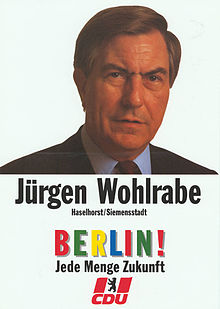Jürgen Wohlrabe
Jürgen Wohlrabe (* 12. August 1936 in Hanau , † 19th October 1995 in Berlin ) was a German politician of the CDU and film producer .
Life
Although he was born in Hanau, Jürgen Wohlrabe grew up in Gardelegen in the Altmark region and at the age of 15, when he was denied further attendance at secondary school, fled the former GDR to West Berlin , where he graduated from high school in 1957 and then went on to study law of the Free University . It was there that he began his political career when he joined the CDU and its student organization RCDS in 1958 and was elected chairman of the General Student Committee (AStA) and Berlin state chairman of the Association of German Student Unions (VDS) in the 1960/61 year of office .
From 1963 to 1967 he was a member of the district assembly of Berlin-Charlottenburg and was then elected to the Berlin House of Representatives before he represented the Berlin CDU in the German Bundestag for ten years from 1969 . During this time, Wohlrabe, who was also the chairman of the Junge Union in Berlin, was one of the most prominent opponents of the student movement around Rudi Dutschke . However, he became known to a broader public primarily through his dispute with Herbert Wehner , who dubbed him in a Bundestag debate in 1970 as an evil crow and four years later even as a pig . In 1968 he had already won the so-called dry piss court case . In 1972 his son Marc Wohlrabe was born.
In 1979 Wohlrabe was again a member of the Berlin state parliament, to which he was to belong until his death. From March 1989 to January 1991 Jürgen Wohlrabe was finally President of the Berlin House of Representatives. In this function, he once again attracted nationwide attention thanks to a rally at Schöneberg Town Hall on the day after the fall of the Berlin Wall on November 10, 1989, for which, as President of Parliament, he was formally host and organizer.
In 1996 it became known that unofficial employees of the Ministry for State Security of the GDR had used Wohlrabe (contact person “Taifun”) as a source and tapped his phone.
In addition to his political career, Jürgen Wohlrabe was also successful as a film salesman and producer. In 1978 he took over the family youth film distribution company founded by his grandfather Willy Wohlrabe and continued by his uncle Karl Friedrich Wohlrabe and developed it into a commercially successful company, among other things through box office hits like Sergio Leone's Once Upon a Time in America , Bernardo Bertolucci's The Last Emperor or Peter MacDonald's Rambo III . As a producer, he was also responsible for Asterix in America (1994).
Jürgen Wohlrabe died of a brain tumor in Berlin in October 1995 at the age of 59 . His final resting place is a hereditary burial at the Heerstraße cemetery in Berlin-Westend (grave location: I-Erb.-Mauer). A slender obelisk serves as a tombstone .
Honors
- 1977: Federal Cross of Merit, 1st class
- 1986: Chevalier de l ' Ordre des Arts et des Lettres
- 1994: Large Federal Cross of Merit
The Wohlrabedamm in Berlin was named after Jürgen Wohlrabe.
literature
- Werner Breunig, Andreas Herbst (ed.): Biographical handbook of the Berlin parliamentarians 1963–1995 and city councilors 1990/1991 (= series of publications of the Berlin State Archives. Volume 19). Landesarchiv Berlin, Berlin 2016, ISBN 978-3-9803303-5-0 , p. 397.
- Rudolf Vierhaus , Ludolf Herbst (eds.), Bruno Jahn (collaborators): Biographical manual of the members of the German Bundestag. 1949-2002. Vol. 2: N-Z. Attachment. KG Saur, Munich 2002, ISBN 3-598-23782-0 , pp. 970-971.
- Film dealer with the Cross of Merit . In: Berliner Zeitung , June 6, 1994.
- A life between Lummer and Leone . In: Der Spiegel . No. 30 , 1987 ( online ).
Web links
- Portrait at the Berlin House of Representatives
Individual evidence
- ↑ Harriet Dreier: "We Wohlrabes are like a lightbulb" . In: Spiegel.de of October 24, 2010
- ^ Operation Swamp . In: Der Spiegel . No. 51 , 1996 ( online ).
- ↑ Then it gets hot . In: Der Spiegel . No. 14 , 2000 ( online ).
- ↑ Peter Stolle: A life between Lummer and Leone. Der Spiegel, 1987, accessed June 25, 2018 .
- ↑ A life between Lummer and Leone . In: Der Spiegel . No. 30 , 1987 ( online ).
- ↑ Manfred Agethen: Jürgen Wohlrabe. Entrepreneurs, politicians . Biography on the website of the Konrad-Adenauer-Stiftung . Retrieved November 13, 2019.
- ^ Hans-Jürgen Mende : Lexicon of Berlin burial places . Pharus-Plan, Berlin 2018, ISBN 978-3-86514-206-1 . P. 497.
| personal data | |
|---|---|
| SURNAME | Wohlrabe, Jürgen |
| BRIEF DESCRIPTION | German politician (CDU), MdA, MdB, President of the Berlin House of Representatives 1989–1991 |
| DATE OF BIRTH | August 12, 1936 |
| PLACE OF BIRTH | Hanau |
| DATE OF DEATH | October 19, 1995 |
| Place of death | Berlin |


